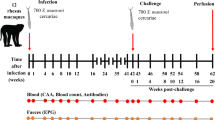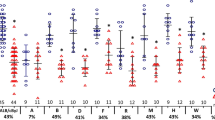Abstract
PREVIOUS investigations1,2 have produced information concerning the manner in which prior exposure of mice to irradiated cercariæ of Schistosoma, mansoni affects the course of the challenge infection. The results indicated that the principal effect of the aborted infection with irradiated cercariæ was to slow the migration and development of worms from the challenge infection. The delay in accumulation of recoverable worms and eggs suggested the probability of inhibitory factors being produced by the aborted infection with irradiated cercariæ, although their relation to specific acquired resistance could not be defined.
This is a preview of subscription content, access via your institution
Access options
Subscribe to this journal
Receive 51 print issues and online access
$199.00 per year
only $3.90 per issue
Buy this article
- Purchase on Springer Link
- Instant access to full article PDF
Prices may be subject to local taxes which are calculated during checkout
Similar content being viewed by others
References
Perlowagora Szumlewicz, A., and Olivier, L. J., Science, 140, 411 (1963).
Perlowagora Szumlewicz, A., Bull. WHO, 30, 401 (1964).
Wilcoxon, F., Biometrics, 1, 80 (1945).
Fisher, R. A., Statistical Methods for Research Workers, fifth ed. 21.02 (1934).
Author information
Authors and Affiliations
Rights and permissions
About this article
Cite this article
PERLOWAGORA-SZUMLEWICZ, A. Schistosoma mansoni: Humoral Transfer of Protective Factors produced by Irradiated Cercariæ. Nature 204, 1009–1010 (1964). https://doi.org/10.1038/2041009a0
Issue Date:
DOI: https://doi.org/10.1038/2041009a0
Comments
By submitting a comment you agree to abide by our Terms and Community Guidelines. If you find something abusive or that does not comply with our terms or guidelines please flag it as inappropriate.



